#tarotqabalahthothmagickelitarotstrickingly.com
Above all things know thyself.

Thoth-Knight of Cups
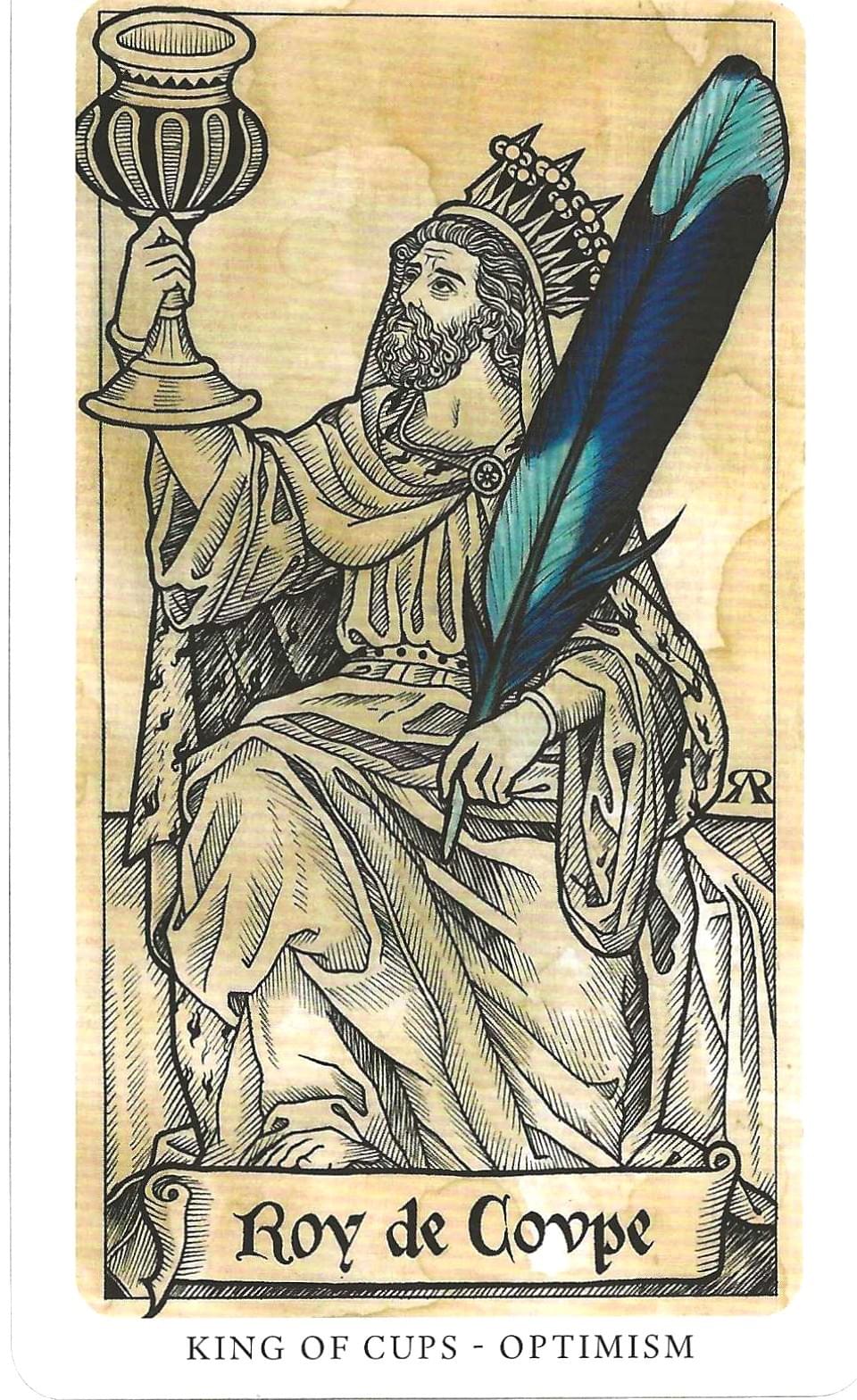
The Medieval Feathers Tarot- King of Cups
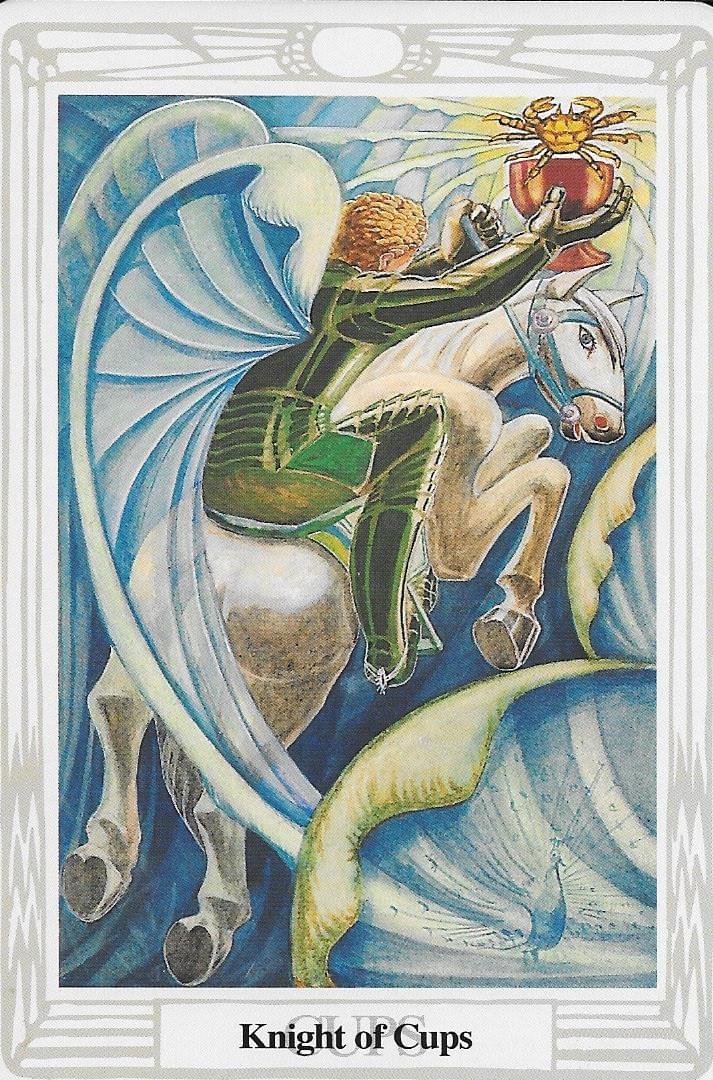
The Thoth Knight of Cups
Lord of the Waves and the Waters
King of the Hosts of the Sea
King of Nymphs and Undines
In the Thoth Tarot, the Kings of other decks are called Knights, for Crowley followed the divine creative formula of the Tetragrammaton (YHVH). This subtle shift is vital to Hermetic understanding. The King is not a passive ruler seated on a throne but an active, fiery rider of force—a dynamo of elemental energy in motion. The Knight is the Father, the fiery Yod, whose essence impregnates the elemental field.
The Thoth Knight of Cups is the Fiery Part of Water. At first this may appear paradoxical, but the alchemist knows fire and water are not enemies—they unite as solution and dissolution, the ceaseless process of mixing, blending, and transformation. In this way, he is the Power of Solution: the fiery agent that dissolves and recombines, changing the shape of all things through the mystery of fluid union.
Personality and Disposition
This archetype reflects a personality of hidden intensity.
On the surface, he is calm, amiable, and magnetic. Like still waters, his presence soothes the troubled. He appears passive, compassionate, and tender.
Yet beneath that surface run powerful, often dangerous currents. The Knight of Cups is a master of emotional secrecy, brooding depths, and passionate tides.
In business, such a person often follows hunches and intuition, making uncanny decisions that prove successful. However, there is a ruthless undertone—he does not hesitate to dissolve obstacles or rivals if they block his stream of purpose.
In love, he is fervent, romantic, and poetic. This is the archetype of the Lover who intoxicates and overwhelms, whose tenderness masks a consuming fire. The Knight of Cups draws vitality from acts of kindness, empathy, and union, but when crossed, his waters turn tempestuous.
Qabalistic and Elemental Role
Yod of Heh (Father of the Cup suit) – His fiery essence enflames water, stirring it into motion. Without this active element, water would remain inert and stagnant.
Solution & Dissolution – In alchemy, he represents the dissolving power of liquids—the way fire within water breaks down, purifies, and reforms.
Undines and Nymphs – As King of the Hosts of the Sea, he rules the elemental water spirits, those who embody desire, longing, and psychic fluidity.
The Knight of Cups thus exemplifies the paradox of movement within stillness, passion within calm, fire within water.
Light and Shadow
Light Expression:
Intuitive guidance, poetic inspiration
Tenderness and empathy toward others
Passionate lover and loyal companion
Spiritual dissolver of boundaries, mystic of the heart
Shadow Expression:
Brooding secrecy and emotional manipulation
Ruthlessness under a gentle mask
Mood swings, tempests of passion
Escapism into fantasy, indulgence, or intoxication
Hermetic Insight
To meditate on the Knight of Cups is to learn how fire hides in water—how passion is concealed within calm, and how the dissolving stream secretly reshapes the world. He teaches the Magus that emotion is not weakness, but a solvent power that breaks down illusions and bonds together new realities.
He is the Poet-Knight of the Waters, who rides the waves of intuition, carrying us into the unknown depths of the Soul.


The Qabalistic Tree of Life

The Thoth Knight of Cups
The Fiery Part of Water
Lord of the Waves and the Waters
The Thoth Knight of Cups embodies the paradox of the Fiery Part of Water—the power of solution, dissolution, and regenerative flow. His action is not unlike the sudden attack of rainstorms, or the irresistible surge of springs that break through stone. He represents the fire hidden within the depths of water: passion, force, and brilliance concealed beneath calm and reflective surfaces.
Astrological Domain
He rules the zodiacal span from the 21st degree of Aquarius to the 20th degree of Pisces, a realm that bridges intellectual idealism with mystical sensitivity. In this way, the Knight of Cups encompasses the visionary power of Aquarius’ fixed Air and the deep psychic tides of Pisces’ mutable Water. His dominion unites universal vision with emotional depth.
Qabalistic Root
All Tarot Kings (Knights in the Thoth deck) radiate their authority from the Second Sephirah—Chokmah, Wisdom. Chokmah is the primal masculine outpouring, the fiery Yod of the Tetragrammaton, which fertilizes and sets into motion the passive forms of Binah. Thus, the Knight of Cups is Wisdom’s fiery essence clothed in watery garments. He demonstrates how Chokmah’s force is refracted through the suit of Water, producing intuition, receptivity, and dissolving power that is nevertheless active and fiery.
Iconography of the Card
The Armor, Bright Wings, and White Charger – These represent the most active expressions of Water. Water is rarely stagnant; it moves, cascades, and flows, often violently breaking barriers. The Knight is armored yet winged, showing both protection and freedom of motion, while his steed leaps forward with unrestrained vitality.
The Crab – Seen on his cup, the crab reflects Water’s aggressive and regenerative nature. Just as crabs shed their shells, so too does the Knight shed his armor—revealing the ability to become more vulnerable, tender, and empathetic when needed. This regenerative symbolism also links him with the lunar tides and the sign of Cancer, another watery emblem.
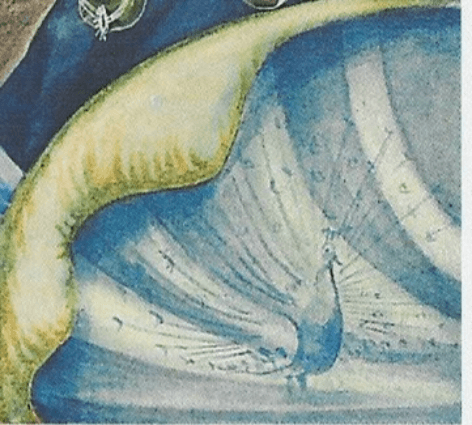
The Peacock (Totem) – In the lower right corner appears the Peacock, symbol of brilliance, iridescence, and splendor. Active water catches and reflects light like a prism, mirroring the Peacock’s jeweled feathers. In Hindu mythology, the peacock is associated with Kartikeya and Saraswati, embodying victory, wisdom, and beauty. In Western myth, the Peacock is sacred to Argus Panoptes, the many-eyed guardian who saw all—reminding us that the Knight of Cups embodies penetrating vision and all-surveying awareness.
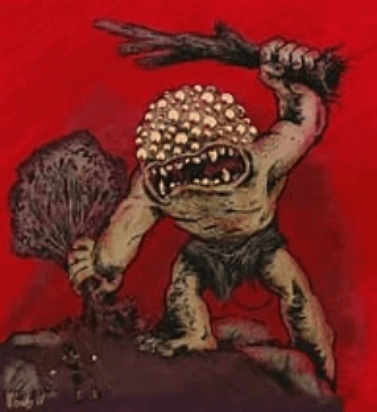
Argus Panoptes,
Hermetic Interpretation
The Knight of Cups is a bearer of paradox: fiery passion hidden within watery calm. He can appear gentle, empathetic, and intuitive, yet beneath this surface lies a force capable of sudden storms. Like rain or springs bursting forth, his influence is both life-giving and destructive, soothing and overwhelming.
To meditate upon him is to confront the mystery of Water’s Fire: the solvent that breaks down forms, dissolves boundaries, and recombines them into something new. He teaches the aspirant to embrace fluidity without passivity—to wield empathy as a force, and intuition as a weapon.
Summary of Forces
Element: Fiery Part of Water (Solution, Dissolution, Regeneration)
Sephirothic Root: Chokmah (Wisdom, Yod of YHVH)
Astrological Span: 21° Aquarius – 20° Pisces
Totem Animal: Peacock (splendor, iridescence, penetrating vision)
Symbols: White Charger, Crab, Peacock, Winged Armor
Nature: Passionate, intuitive, empathetic, yet capable of stormy violence
Peacock

Hindu Peacock God-Mayura
The Peacock and Argus: Mythic Reflections in the Thoth Knight of Cups
Whether the fixed, unblinking eyes of the Peacock’s feathers are truly the tragic eyes of Hera’s faithful watchman, Argus, is left to mystery. Yet for millennia the tale has compelled human imagination. The Peacock, resplendent in shimmering hues, became a living emblem of the transforming power of love, devotion, and trust—a bond between goddess and servant, mistress and bondman.
As the story unfolds, Hera charged her hundred-eyed giant Argus to watch over Io, the river nymph upon whom Zeus had set his wandering desire. Argus, ever-vigilant, never closed all his eyes at once. Yet Zeus, master of disguise and cunning manipulation, lulled Argus into a state of dreamlike sleep. In that suspended moment of vulnerability, Zeus severed the giant’s head. Hera, overcome with grief, sought a way to honor her loyal companion. She gathered Argus’s many eyes and placed them in the tail of the Peacocks that drew her chariot.
In this gesture, Hera preserved not only the watchful devotion of Argus, but also the poignancy of his failure—the paradox of vigilance undone by divine trickery. The Peacock’s feathers became a reminder both of love’s loyalty and of its tragic vulnerability in the hands of power.
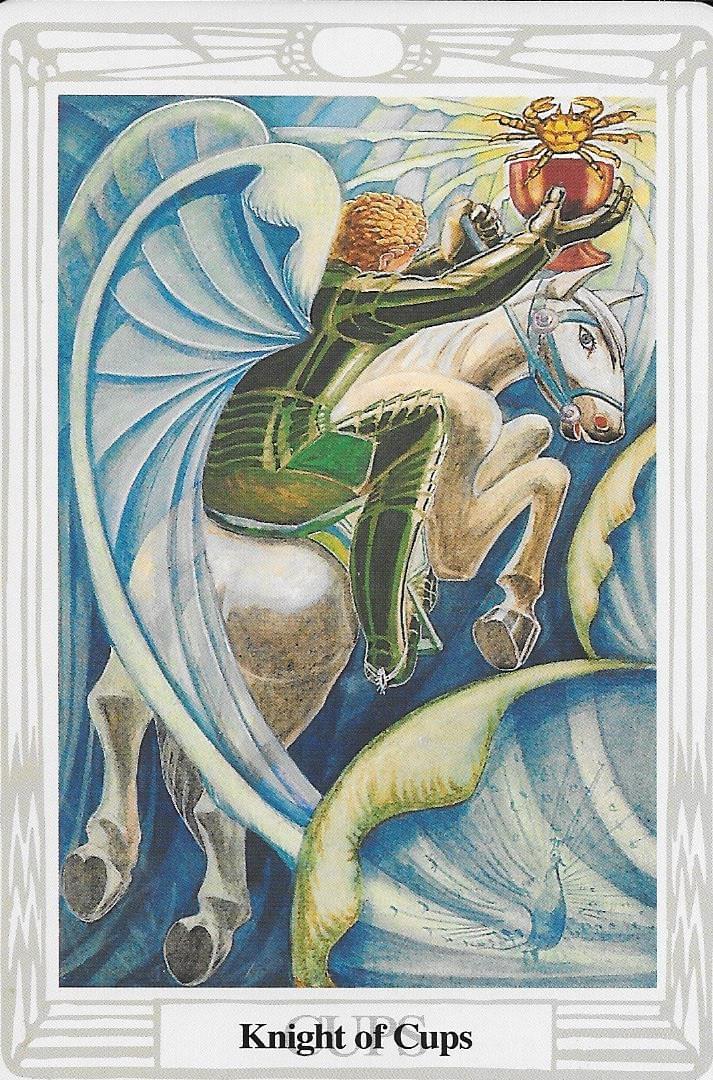
Hermetic Connection to the Knight of Cups
In the Thoth Tarot, the Peacock is the totem of the Knight of Cups—the radiant splendor of active water, reflecting light in jeweled brilliance. Just as Hera’s Peacock bears Argus’s eyes, the Knight of Cups embodies the eternal watcher of the Grail: devoted, vigilant, yet ever at risk of being deceived by glamour or illusion.
The Many Eyes – Argus’s eyes, now eternalized in Peacock feathers, mirror the penetrating insight of the Knight of Cups. Though he may appear calm and passive, his perception is many-faceted, able to discern subtle flows beneath the surface.
The Devotion to Hera – Argus’s loyalty, though tragically betrayed, symbolizes the Knight’s unwavering devotion to the Grail / Creatrix, the source of all flowing life. He is the lover-knight who pours himself out in service to the Feminine Divine, whether as nymph, goddess, or archetypal Anima.
The Tragic Undercurrent – Just as Argus’s vigilance was undone by sleep, the Knight of Cups may fall prey to illusion or self-deception. His emotional nature, so tuned to beauty and devotion, can be exploited by forces greater or subtler than himself.
Thus, the myth of Argus becomes a mirror for the Knight of Cups: a figure of passionate loyalty, emotional brilliance, and mystical watchfulness, whose shadow is the danger of losing oneself to illusion, or being betrayed by misplaced trust.
Hermetic Lesson
The Peacock’s feathers, glimmering with Argus’s eyes, remind us that loyalty to the Grail is never wasted, even when tragedy strikes. The Knight of Cups carries within himself both the poet’s devotion and the warrior’s vulnerability. His strength lies in his willingness to serve the higher vision of the Soul (the Grail/Creatrix), yet his challenge is to guard against the dreamy intoxication of illusion.
In contemplating this Knight, we learn that true love and trust are not diminished by failure. Even when vigilance falters, the spirit of devotion is transmuted into eternal brilliance—just as Argus’s eyes shine forever in the Peacock’s tail.


The Peacock in Hindu Myth and the Knight of Cups
In the Indian and Hindu context, the Peacock is layered with complex mythological roles, yet one element is constant: its origin from the feathers of Garuda, the mighty eagle who is the mount of Lord Vishnu. Garuda is the eternal carrier through the corridors of time, maintaining cosmic balance even as creation and dissolution cycle endlessly in Vishnu’s dream. The Peacock, born of his feathers, inherits not only Garuda’s brilliance and beauty, but also his fearlessness of serpents and his power over time itself.
Time, Serpents, and the Peacock’s Power
The most fascinating metaphoric thread of the Peacock is its intimate connection to Time.
In Hindu cosmology, the serpent is not merely an animal—it is a symbol of cyclical time (Kala), forever coiling, uncoiling, and devouring its own tail.
By devouring snakes, the Peacock is said to break the cycle, transcending the endless round of time-bound existence.
This myth aligns beautifully with biological truth: peafowls can indeed eat poisonous snakes without suffering harm, a striking natural emblem of their mythic invulnerability.
Thus, the Peacock becomes more than a symbol of splendor—it is an emblem of the soul’s power to overcome the cycles of mortality, dissolving time’s repetitive coils and stepping into a higher continuity.
Integration with the Thoth Knight of Cups
Placed in the Thoth Tarot as the totem of the Knight of Cups, the Peacock embodies the brilliance and fiery activity of Water. Here, two worlds of mythos intersect:
In the Greek myth, the Peacock’s feathers hold the eyes of Argus, eternalized by Hera—emblems of loyalty, vigilance, and devotion to the Grail/Creatrix.
In the Hindu myth, the Peacock is born of Garuda’s feathers, inheriting the cosmic role of transcending time by devouring serpents, the very symbols of cyclical bondage.
Together, these myths illuminate the dual polarity of the Knight of Cups:
Devotion and vigilance (Argus’ eyes)
Transcendence of time and mortality (Garuda’s Peacock)
The Knight of Cups thus embodies not only the passionate lover and watcher of the Grail, but also the soul’s ability to dissolve time-bound illusion—breaking cycles, consuming poisons, and reflecting back the splendor of eternal renewal.
Hermetic Lesson
The Peacock’s myth tells us that Water’s Fire is not merely emotional passion—it is also the alchemical solvent of time itself. Just as the Peacock devours serpents, so too can the aspirant dissolve repetitive karmic patterns, transcending the hypnotic coils of cyclical existence.
In this light, the Knight of Cups is the active devotion of the Soul to its eternal Source, riding the leaping charger of Chokmah’s wisdom through the waters of incarnation, yet bearing the Peacock’s reminder that time’s cycles may be dissolved by vigilance, beauty, and fearless love.

Often many mythological god traits are represented in one Thoth Tarot Card. The Knight of Cups is no exception for in Western Myth, this card also represents Dewi, the ancient lord of the Abyss, who is also latter known as Bran or Bron the blessed who later became the Christianized Fisher King or Rich Fisher named Bron. He represents ageless power and strength, a reliable protector of the needy with a quality of irresistible force underlying a calm surface.

Nodens- Lord of the Oceans
The fluorescence characteristics of the person's personality, born between Feb. 19 to Mar 20th, signified by this card are surprisingly passive, as dictated by the Zodiacal attribution. With the qualities of Venus, s/he is a graceful dilettante (a weak Jupiter) who is amiable and quick to respond to attraction, but the stimulation fades away as s/he is not very enduring. Emotionally triggered by outside influence, this person has no real material depth of character. Therefore, the Knight of Cups has an undeniable innocence and purity that is hardly clouded by their ill dignified sensuality, idleness, and untruthful nature (a storyteller). In fact, this persona may be so superficial that it is hard to reach any depth in them. But in truth, he or she is a really "nice guy or gal".

The figure of the Fisher King in Arthurian legend is believed to have roots in Celtic mythology, particularly in the tales of deities associated with the abyss or the deep sea. One such deity is Nodens, a Celtic god worshipped in ancient Britain, associated with healing, the sea, hunting, and wealth. Nodens is sometimes referred to as the "Lord of the Great Abyss."
In Arthurian legend, the Fisher King is the guardian of the Holy Grail, often depicted as suffering from a wound that renders him impotent and his kingdom barren. He awaits a hero, typically Percival or Galahad, to heal him and restore the land. The Knight of Cups actually represents Galahad the emotional healing hero.
The connection between the Fisher King and Celtic deities like Nodens suggests a blending of mythologies, where earlier Celtic gods associated with the sea and healing influenced the development of later medieval legends.

Tarot personality birth-wheel
To be sure, there is great difficulty in rightly mating water with Fire, as the swift violent nature of fire (Will to Force) ill suits a character that is naturally as placid as water (Will to Form). It is a rare persona indeed that has mastered the balance, so most often we find this personality mismanaging their affairs and unless good fortune attends them through the Jupiter connection, their career and life is littered with a trail of failure and disaster. Hence, the wounded Fisher King association.
There can be a mental "civil war" here, which can lead to depressions, and/or schizophrenia. The abuse of stimulants, alcohol, and narcotics is not uncommon with such a personality. As is often the case, the surrounding cards will help the Reader decide the positive or ill dignified nature of this card and within the reading along with the recommended nature of correcting the unwanted behavior of this ill dignity. All in all, a very fun bubbly, bright person to be around---as long as you show attraction, to stimulate his/her attention. Good fun for short visits!


Pisces

The Medieval Feathers Tarot- King of Cups-Optimism
Medieval Feathers Tarot – King of Cups
The Wounded Healer, the Fisher King
The King of Cups in the Medieval Feathers Tarot is no mere figure of power and command—he is a King wearied by the long burden of keeping his kingdom intact. His reign has been marked by sacrifices, compromises, and constant efforts to please, so that he may remain esteemed in the eyes of his people. Yet in his personal life, the echoes of former joy—a marriage once filled with love, a family now distant and silent—linger as hollow reminders of what has been lost.
What weighs most heavily on him is not his personal sorrow, but the sight of his people’s hope dwindling. He feels the despair of his kingdom in his very bones, knowing there is little he can do to turn the tide alone. And yet, in his hand he clutches the Kingfisher’s feather, linking him with the ancient myth of the Fisher King, whose wound was tied to the sterility of his land. The feather becomes a symbol of his unyielding optimism: though wounded, he radiates the possibility of healing, projecting hope for those who look to him for guidance.
Upright / Light Meaning
This card represents a situation where emotional maturity and equanimity are required. The King of Cups is the master of non-attachment, able to understand and honor the perspectives of others without being swept away in their turmoil.
It signals the potential for healing deep emotional wounds, whether personal or collective. His optimism, though fragile, is a light that can inspire hope in others.
As an archetype, the King of Cups embodies those who persuade others to see the brighter side of life. His optimism is not naïve, but forged from a long mastery of sorrow and resilience.
Reversed / Shadow
Surrounded by toxicity for too long, the King’s waters have grown poisoned. The negativity of others has seeped into his emotional body, leaving him bitter, irritable, and drained.
In this shadow state, the King of Cups warns that emotional boundaries have been eroded. One has taken on energies not one’s own, and now they corrode the spirit.
The counsel here is clear: it is time to cut away from these influences, to seek cleansing, purification, and renewal. Spiritual practices of banishing and clearing—whether ritual baths, smudging, or Qabalistic purification rites—will restore harmony to the inner waters.
Hermetic Insight
The Fisher King wound is at the heart of this card. In Arthurian Grail lore, the King’s wound and the kingdom’s sterility are one. So too, the King of Cups reminds us that our inner wounds project onto the world around us. To heal the land, we must heal the King within.
The Kingfisher feather, held as a talisman, is not just a symbol of optimism but of the possibility of regeneration through empathy, love, and hope. The King of Cups teaches that true mastery of the emotional self is not freedom from sorrow, but the ability to transmute sorrow into hope—a Grail-like elixir that heals not only oneself, but all who drink from it.
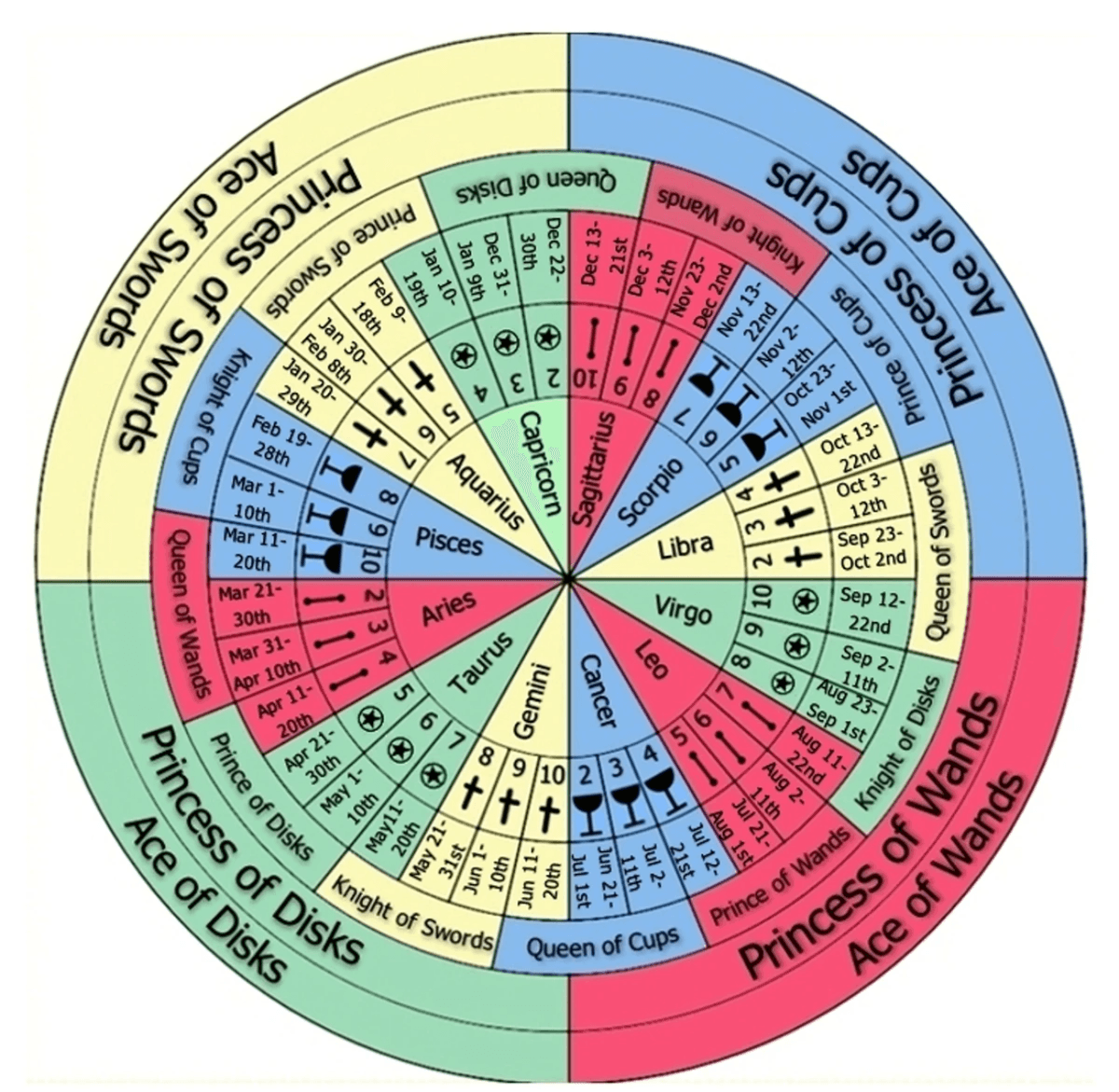
Some of the modern personalities associated with the Knight of Cups/King of Cups Tarot Card are:
Sonny Bono, Mia Farrow, and Burt Reynolds. However, there is something in this card that engenders the likes of George Washington, Abraham Lincoln, Susan B. Anthony, and Thomas Edison all of whom sport more depth than this card displays. This might be because this card also represents the Myth of Dewi, the ancient lord of the Abyss, who is also known as Bran the blessed who later became the Christianized Fisher King or Rich Fisher named Bron. He represents ageless power and strength, a reliable protector of the needy with a quality of irresistible force underlying a calm surface.
WHEN THE KNIGHT/KING OF CUPS IS THROWN DURING A READING, IT IMPLIES:
- The optimist.
- Issues with family and/or relationships.
- The Spirit of Water; intuitive.
- One has attained their position of authority by listening to their conscientious, by action and looking ahead into life.
- Becoming aware that a psychic process in one’s life has come to an end.
- Releasing and old emotion by realizing it has run its course and is no longer operative in one’s life.
- The ability to love.
- A counselor or caregiver who is creative and imaginative.
- A seductive personality that is good in the art of love.
- A powerful, dominating person.
If ill defined by the surrounding cards, it implies:
- Seductibility.
- Duplicity.
- Instability.
- Helper syndrome.
Thank you for your interest, comments and supportive donations. Your generosity blesses you. May you live long and prosper.
Thoth Master Class: Western Hermetic Qabalah & Tarot
One-on-One Esoteric Training with Magus Eli
Awaken Your Resonance with the Thoth Tarot
This is not an ordinary Tarot class. The Thoth Master Class is a personalized journey into Hermetic Qabalah and the mysteries of the Thoth Tarot, guided one-on-one by Magus Eli.
These sessions are designed to align your soul’s archetypes with the Tree of Life, blending mystical philosophy with hands-on Tarot practice for profound spiritual transformation.
What Makes This Class Unique?
Private Instruction: Just you and the Magus in a 2-hour Google Meet session — fully tailored to your goals.
Flexible Scheduling: Weekly, every two weeks, or monthly (12 sessions recommended for full mastery).
Recorded Lessons: Every session is recorded for your personal review and ongoing study.
Hermetic Depth: Learn Tarot as a gateway to the Tree of Life, elemental forces, and pathworking.
Practical Mastery: Practice Tarot layouts live with guided interpretation to build confidence and resonance.
What You’ll Learn
The structure of the Thoth Tarot: Major Arcana, Minor Arcana, and Court Cards
The Western Hermetic Qabalah: Ten Sephiroth, Four Worlds, and 22 Paths
Pathworking and meditative techniques using Tarot as a key to inner temples
Hermetic spreads and ritual applications for personal transformation
Developing personal gnosis and building your own mystical framework
Required Materials
The Qabalistic Tarot: A Textbook of Mystical Philosophy by Robert Wang
Thoth Tarot deck (Crowley/Harris edition preferred)
Personal journal or Book of Shadows
Is This Class for You?
No prior Tarot experience is required — beginners and advanced seekers are welcome.
Perfect for anyone drawn to Hermetic wisdom, deep archetypal work, and personal gnosis.
How to Enroll
Email eli@elitarotstrickingly.com to request availability and begin your personalized resonance mapping session. So that all aspirants can gain self-mastery, my fees will be adjusted to fit their budget. All people are welcome to Above all things, Know thyself.
Call to Action
Awaken the archetypes within. Enter the living mysteries of the Thoth Tarot. Begin your Master Class today.
3 Western Hermetic Tarot and Magick websites helping people become more magic and less tragic since 2010.
For more information concerning individual-online-Thoth Tarot readings and/or Thoth Tarot Card master classes, just log onto-www.elitarotstrickingly.com-and click on the Tarot/Store page. Thank you.
Traditional Tarot Card Comparisons blogs and tarot store.
Western Hermetic Ritual Magick website and blog.
